Extraction of bioactive compounds from the flavedo/albedo and from Citrus paradisi Macfad flour subjected to different processes
DOI:
https://doi.org/10.20435/multi.v25i61.1937Keywords:
pomelo, antioxidant activity, ascorbic acid, heat treatmentAbstract
Citrus paradisi Macfad are an excellent source of nutrients and important phytochemicals for a healthy diet. In this context, the knowledge of the chemical composition of foods is fundamental to evaluate the nutrient contents and their health benefits. However, one of the problems related to the consumption of pomelo is the bitter taste that comes from the naringin present in the peel, making it important to develop a flour with a reduced content of bitter taste. The determinations were made in the peel, flavedo, and albedo, in the flour obtained by thermal processing of 48 hours, flour by thermal processing of 72 hours, flour processed and washed in cold water and crushed flour, washed in cold water and processed. To determine ascorbic acid, the titration method was used, and the other bioactives were determined by spectrophotometry. Aqueous, hydroacetonic, and ethanolic extracts were used to determine the total phenolic compounds, total tannins. Antioxidant activity was determined by the photocolorimetric method of the stable free radical DPPH. The flour with 72-hour thermal processing had decreased its concentration of bioactive, and the flour that has been obtained by the peel and albedo before being processed had the highest concentrations; thereof, highlighting discrepant increase of ascorbic acid relative to the other. The carotenoid content showed no significant differences between the samples. Among all treatments, the flour obtained by cold water processing, not being crushed before being processed, had reduced the bitterness of naringin.
References
ABDILLE, M. D. H.; SINGH, R. P.; JAYAPRAKASHA, G. K.; JENA, B. S. Antioxidant activity of the extracts from Dillenia indica fruits. FoodChem, Washington, v. 90, p. 891-6, 2005.
ALI, S. S.; KASOJU, N.; LUTHRA, A.; SINGH, A.; SHARANABASAVA, H.; SAHU, A.; BORA, U. Indian medicinal herbs as sources of antioxidants. Food Research International, v. 41, p. 1-15, 2009.
BRASIL. Resolução RDC n. 2, de 7 de janeiro de 2002. Regulamento técnico de substâncias bioativas e probióticos isolados com alegação de propriedades funcional e/ou de saúde. Diário Oficial da União, Brasília-DF, 17 de julho de 2002.
HAVSTEEN, B. H. The biochemistry and medical significance of the flavonoids. Pharmacology & Therapeutics, v. 96, p. 67-202, 2002.
HEINONEN, M.; LEHTONEN, P. J.; HOPIA, A. Antioxidative activity of berry and fruit wines and liquor. Journal of Agricultural and Food Chemistry, Washington, v. 48, p. 25-31, 1998.
HORWITZ, W. (Ed.).Vitamin C in foods. In: HORWITZ, W. (Ed.). Official Methods of Analysis of the Association of Official Analytical Chemists. 18. ed. Gaithersburg: AOAC, 2005. [Official Method 967.26].
ISMAIL, A.; MARJAN, Z. M.; FOONG, C. W. Total antioxidant activity and phenolic content in selected vegetables. Food Chemistry, Washington, v. 87, p. 581-6, 2004.
KAUR, C.; KAPOOR, H. C. Anti-oxidant activity and total phenolic content of some Asian vegetables. International Journal of Food Science & Technology, Oxford, v. 37, p. 153-61, 2002.
LEE, S. E.; HWANJ, H. J.; JEONG, H. S.; JEONG, H. K. Screening medicinal plant extracts for antioxidant activity. Life Science, v. 73, p. 167-79, 2003.
Mello, J. P. C.; Santos, S. C. Taninos. In: Simões, C. M. O.; Schenckel, E. P. (Org.). Farmacognosia: da planta ao medicamento. 3. ed. Porto Alegre: Ed. UFSC, 2001.
NAGATA, M.; YAMASHITA, I. Simple method for simultaneous determination of chlorophyll and carotenoids in tomato fruit. Nippon. Shokuhin Kogyo Gakkaisk, v. 39, n. 10, p. 925-8, 1992.
PIZZI, A. Advanced wood adhesives technology. New York: Marcell Dekker, 1994. 289p.
ROSS, J. A.; KASUM, C. M. Dietary Flavonoids: Bioavailability, Metabolic Effects, and Safety. Annual review of Nutrition, n. 22, 19-34, 2002.
SAXENA, R. K.; SHARMILA, P.; SINGH, V. P. Microbial degradation of taninnis. Progress in Industrial Microbiology, v. 32, p. 259-70, 1995.
SENA, D. N.; OLIVEIRA, A. F. R.; SOUSA, M. M. A.; ALMEIDA, M. M. B.; SOUSA, P. H. M. Farinha de Resíduos de Processamento de Frutas Tropicais: determinação dos seus potenciais antioxidante. In: CONGRESSO BRASILEIRO DE ENGENHARIA QUÍMICA, 20., 19 a 22 de out. 2014, Florianópolis, SC. Anais [...]. Florianópolis: COBEQ, 2014.
SWAIN, T.; HILLIS, W. E. The phenolics constituents of Prumus domestica: the quantitative analysis of phenolic constituents. Journal of Science Food Agriculture, v. 10, p. 63-8, 1959.
YEN, G. C.; DUH, P. D. Scavenging effect of methanolic extracts of peanut hulls on free-radical and active-oxygen species. J. Agric. Food Chemistry, v. 42, p. 629-32, 1994.
Downloads
Published
How to Cite
Issue
Section
License
Os artigos publicados na Revista Multitemas têm acesso aberto (Open Access) sob a licença Creative Commons Attribution, que permite uso, distribuição e reprodução em qualquer meio, sem restrições desde que o trabalho original seja corretamente citado.
Direitos Autorais para artigos publicados nesta revista são do autor, com direitos de primeira publicação para a revista. Em virtude de aparecerem nesta revista de acesso público, os artigos são de uso gratuito, com atribuições próprias, em aplicações educacionais e não-comerciais.


